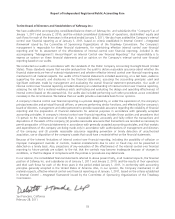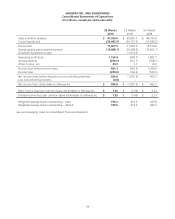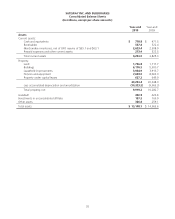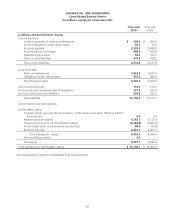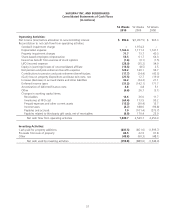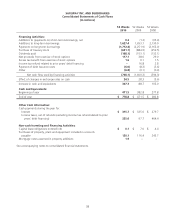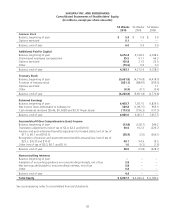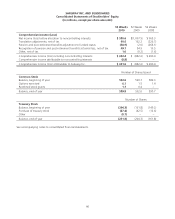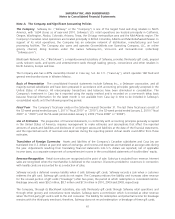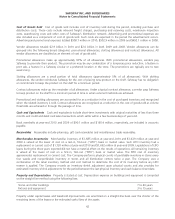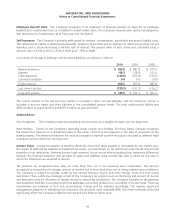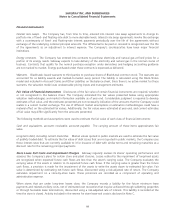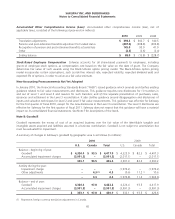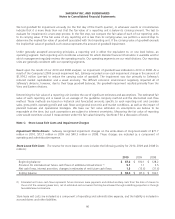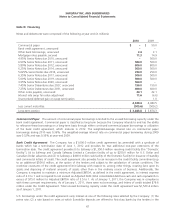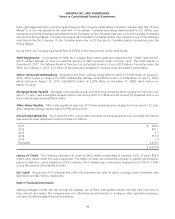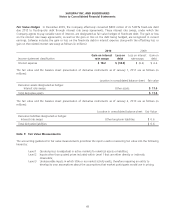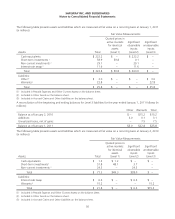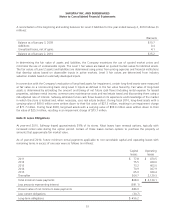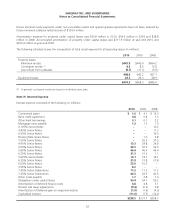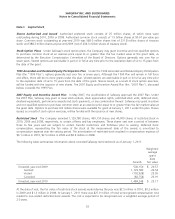Safeway 2010 Annual Report Download - page 59
Download and view the complete annual report
Please find page 59 of the 2010 Safeway annual report below. You can navigate through the pages in the report by either clicking on the pages listed below, or by using the keyword search tool below to find specific information within the annual report.
SAFEWAY INC. AND SUBSIDIARIES
Notes to Consolidated Financial Statements
Employee Benefit Plans The Company recognizes in its statement of financial position an asset for its employee
benefit plan’s overfunded status or a liability for underfunded status. The Company measures plan assets and obligations
that determine the funded status as of fiscal year end. See Note K.
Self-Insurance The Company is primarily self-insured for workers’ compensation, automobile and general liability costs.
The self-insurance liability is determined actuarially, based on claims filed and an estimate of claims incurred but not yet
reported, and is discounted using a risk-free rate of interest. The present value of such claims was calculated using a
discount rate of 2.0% in 2010, 2.75% in 2009 and 1.75% in 2008.
A summary of changes in Safeway’s self-insurance liability is as follows (in millions):
2010 2009 2008
Beginning balance $ 453.8 $ 487.8 $ 477.6
Expense 148.3 128.8 161.6
Claim payments (134.0) (163.4) (150.5)
Currency translation 0.4 0.6 (0.9)
Ending balance 468.5 453.8 487.8
Less current portion (129.5) (131.7) (126.2)
Long-term portion $ 339.0 $ 322.1 $ 361.6
The current portion of the self-insurance liability is included in other accrued liabilities, and the long-term portion is
included in accrued claims and other liabilities in the consolidated balance sheets. The total undiscounted liability was
$506.4 million at year-end 2010 and $507.9 million at year-end 2009.
Deferred Rent
Rent Escalations. The Company recognizes escalating rent provisions on a straight-line basis over the lease term.
Rent Holidays. Certain of the Company’s operating leases contain rent holidays. For these leases, Safeway recognizes
the related rent expense on a straight-line basis at the earlier of the first rent payment or the date of possession of the
leased property. The difference between the amounts charged to expense and the rent paid is recorded as deferred lease
incentives and amortized over the lease term.
Income Taxes Income tax expense or benefit reflects the amount of taxes payable or refundable for the current year,
the impact of deferred tax liabilities and deferred tax assets, accrued interest on tax deficiencies and refunds and accrued
penalties on tax deficiencies. Deferred income taxes represent future net tax effects resulting from temporary differences
between the financial statement and tax basis of assets and liabilities using enacted tax rates in effect for the year in
which the differences are expected to reverse.
Tax positions are recognized when they are more likely than not to be sustained upon examination. The amount
recognized is measured as the largest amount of benefit that is more likely than not of being realized upon settlement.
The Company is subject to periodic audits by the Internal Revenue Service and other foreign, state and local taxing
authorities. These audits may challenge certain of the Company’s tax positions such as the timing and amount of income
and deductions and the allocation of taxable income to various tax jurisdictions. The Company evaluates its tax positions
and establishes liabilities in accordance with the applicable accounting guidance on uncertainty in income taxes. These tax
uncertainties are reviewed as facts and circumstances change and are adjusted accordingly. This requires significant
management judgment in estimating final outcomes. Actual results could materially differ from these estimates and could
significantly affect the Company’s effective tax rate and cash flows in future years.
43


